提单BL电子档
- 格式:doc
- 大小:47.00 KB
- 文档页数:2
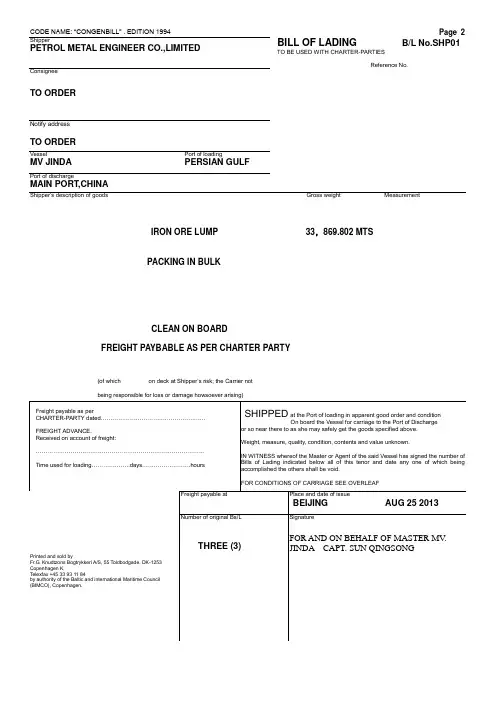
CODE NAME: “CONGENBILL” . EDITION 1994Page 2ShipperPETROL METAL ENGINEER CO.,LIMITED BILL OF LADING B/L No.SHP01 TO BE USED WITH CHARTER-PARTIESReference No.ConsigneeTO ORDERNotify address TO ORDERVesselMV JINDA Port of loading PERSIAN GULFPort of dischargeMAIN PORT,CHINAShipper’s description of goods Gross weight MeasurementIRON ORE LUMP 33,869.802 MTSPACKING IN BULKCLEAN ON BOARDFREIGHT PAYBABLE AS PER CHARTER PARTY(of which on deck at Shipper’s risk; the Carrier notbeing responsible for loss or damage howsoever arising)Freight payable as perCHARTER-PARTY dated………………………………………………FREIGHT ADVANCE.Received on account of freight: ……………………………………………………………………………Time used for loading………………..days…………………….hoursSHIPPED at the Port of loading in apparent good order and conditionOn board the Vessel for carriage to the Port of Dischargeor so near there to as she may safely get the goods specified above.Weight, measure, quality, condition, contents and value unknown.IN WITNESS whereof the Master or Agent of the said Vessel has signed the number of Bills of Lading indicated below all of this tenor and date any one of which being accomplished the others shall be void.FOR CONDITIONS OF CARRIAGE SEE OVERLEAFFreight payable at Place and date of issueBEIJING AUG 25 2013Printed and sold byFr.G. Knudtzons Bogtrykkeri A/S, 55 Toldbodgade, DK-1253 Copenhagen K,Telexfax +45 33 93 11 84by authority of the Baltic and international Maritime Council (BIMCO), Copenhagen.Number of original Bs/LTHREE (3)SignatureFOR AND ON BEHALF OF MASTER MV.JINDA CAPT. SUN QINGSONGBILL OF LADING Page 1TO BE USED WITH CHARTER-PARTIESCODE NAME: “CONGENBILL”EDITION 1994ADOPTED BYTHE BALTIC AND INTERNATIONAL MARITIME COUNCIL (BIMCO)Conditions of Carriage.(1) All terms and conditions, liberties and exceptions of the Charter Party, dated as overleaf, including the Law and Arbitration Clause, are herewith incorporated.(2) General Paramount Clause.(a) The Hague Rules contained in the International Convention for the Unification of certain rules relating to Bills of Lading, dated Brussels the 25th August1924 as enacted in the country of shipment shall apply to this Bill of Lading. When no such enactment is in force in the country of shipment, the corresponding legislation of the country of destination shall apply, but in respect of shipments to which no such enactments are compulsorily applicable, the terms of the said Convention shall apply.(b) Trades where Hague-Visby Rules apply.In trades where the International Brussels Convention 1924 as amended by the Protocol signed at Brussels on February 23rd 1968 - the Hague-Visby Rules - apply compulsorily, the provisions of the respective legislation shall apply to this Bill of Lading.(c) The Carrier shall in no case be responsible for loss of or damage to the cargo, howsoever arising prior to loading into and after discharge from the Vessel orwhile the cargo is in the charge of another Carrier, nor in respect of deck cargo and live animals.(3) General average.General Average shall be adjusted, stated and settled according to York-Antwerp Rules 1994, or any subsequent modification thereof, in London unless another place is agreed in the Charter Party.Cargo’s contribution to General Average shall be paid to Carrier even when such average is the result of a fault, neglect or error of the Master, Pilot or Crew. The Charterers, shippers and Consignees expressly renounce the Belgian Commercial Code, Part II, Art. 148.(4) New Jason Clause.In the event of accident, danger, damage or disaster before or after the commencement of the voyage, resulting from any cause whatsoever, whether due to negligence or not, for which, or for the consequence of which, the Carrier is not responsible, by statute, contract or otherwise, the cargo, shippers, consignees or the owners of the cargo shall contribute with the Carrier in general average to the payment of any sacrifices, losses or expenses of a General Average nature that may be made or incurred and shall pay salvage and special charges incurred in respect of the cargo. If a salving vessel is owned or operated by the Carrier, salvage shall be paid for as fully as if the said salving vessel or vessels belonged to strangers. Such deposit as the Carrier, or his agents, may deem sufficient to cover the estimated contribution of the goods and any salvage and special charges thereon shall, if required, be made by the cargo, shippers, consignees or owners of the goods to the Carrier before delivery.(5) Both-to-Blame Collision Clause.If the Vessel comes into collision with another vessel as a result of the negligence of the other vessel and any act, neglect or default of the Master, Mariner, Pilot or the servants of the Carrier in the navigation or in the management of the Vessel, the owners of the cargo carried hereunder will indemnify the Carrier against all loss or liability to the other or non-carrying vessel or her owners in so far as such loss or liability represents loss of, or damage to, or any claim whatsoever of the owners of said cargo, paid or payable by the other or non-carrying vessel or her owners to the owners of said cargo and set-off, recouped or recovered by the other or non-carrying vessel or her owners as part of their claim against the carrying Vessel or the Carrier.The foregoing provisions shall also apply where the owners, operators or those in charge of any vessel or vessels or objects other than, or in addition to, the colliding vessels or objects are at fault in respect of a collision or contact.For particulars of cargo, freight,Destination, etc., see overleaf.。
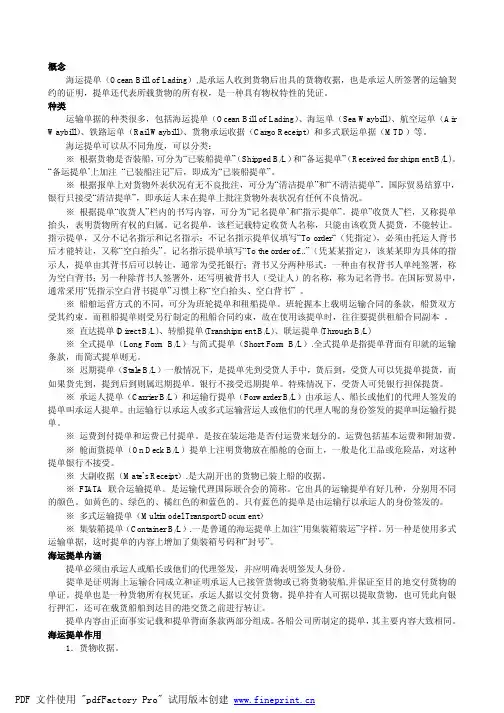
概念海运提单(Ocean Bill of Lading),是承运人收到货物后出具的货物收据,也是承运人所签署的运输契约的证明,提单还代表所载货物的所有权,是一种具有物权特性的凭证。
种类运输单据的种类很多,包括海运提单(Ocean Bill of Lading)、海运单(Sea Waybill)、航空运单(Air Waybill)、铁路运单(Rail Waybill)、货物承运收据(Cargo Receipt)和多式联运单据(MTD)等。
海运提单可以从不同角度,可以分类:※根据货物是否装船,可分为“已装船提单”(Shipped B/L)和“备运提单”(Received for shipment B/L)。
“备运提单’上加注“已装船注记”后,即成为“已装船提单”。
※根据报单上对货物外表状况有无不良批注,可分为“清洁提单”和“不清洁提单”。
国际贸易结算中,银行只接受“清洁提单”,即承运人未在提单上批注货物外表状况有任何不良情况。
※根据提单“收货人”栏内的书写内容,可分为“记名提单’和“指示提单”。
提单”收货人”栏,又称提单抬头,表明货物所有权的归属。
记名提单,该栏记载特定收货人名称,只能由该收货人提货,不能转让。
指示提单,又分不记名指示和记名指示:不记名指示提单仅填写“To order“(凭指定),必须由托运人背书后才能转让,又称“空白抬头”。
记名指示提单填写“To the order of...”(凭某某指定),该某某即为具体的指示人,提单由其背书后可以转让,通常为受托银行;背书又分两种形式:一种由有权背书人单纯签署,称为空白背书;另一种除背书人签署外,还写明被背书人(受让人)的名称,称为记名背书。
在国际贸易中,通常采用“凭指示空白背书提单”习惯上称“空白抬头、空白背书”。
※船舶运营方式的不同,可分为班轮提单和租船提单。
班轮握本上载明运输合同的条款,船货双方受其约束。
而租船提单则受另行制定的租船合同约束,故在使用该提单时,往往要提供租船合同副本。
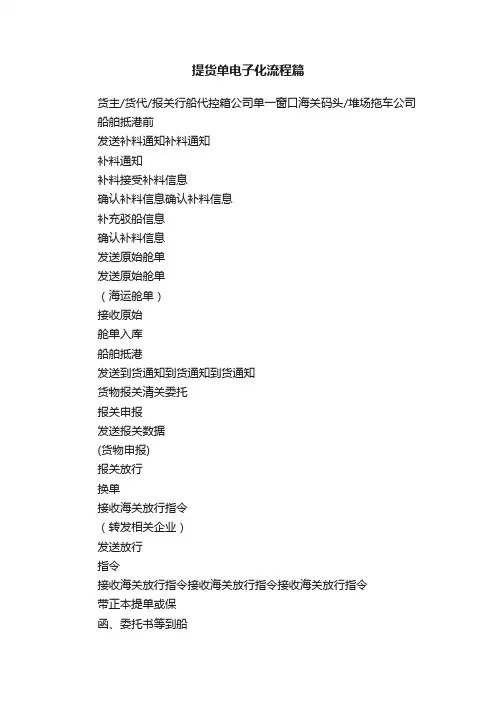
提货单电子化流程篇货主/货代/报关行船代控箱公司单一窗口海关码头/堆场拖车公司船舶抵港前发送补料通知补料通知补料通知补料接受补料信息确认补料信息确认补料信息补充驳船信息确认补料信息发送原始舱单发送原始舱单(海运舱单)接收原始舱单入库船舶抵港发送到货通知到货通知到货通知货物报关清关委托报关申报发送报关数据(货物申报)报关放行换单接收海关放行指令(转发相关企业)发送放行指令接收海关放行指令接收海关放行指令接收海关放行指令带正本提单或保函、委托书等到船代缴费办理手续办理押箱手续发送电子EIR单产生电子EIR校验码输出:设备交接单,校验码(一单一码)接收电子EIR单及电子EIR校验码输出:设备交接单,校验码接收电子EIR单及电子EIR校验码接收电子EIR单及电子EIR校验码办理换单手续、发送电子提货单(产转发电子EIR单生提货单校验码,状态:已放行)。
输出:提货单+校验码接收电子提单(状态:已放行)输出:提货单+校验码接收电子提单(状态:已放行)输入:提货单+校验码接收电子提货单及校验码货物运输提货发起运输委托请求报关行也可以发起提货申请、办理押箱等接收运输委托请求接收运输委托、接收电子提货单和电子EIR单信息码头办单缴费、获取码头作业号接收提箱预约和司机信息接收提箱预约和司机信息,校验设备交接校验码网上预约提箱,绑定车辆、箱号、司机(身份证)信息。
输入设备交接单校验码+码头作业号接收提箱预约和司机信息,校验码头作业号接收箱出闸信息接收箱出闸信息司机扫身份证入闸提货货运运输还箱接收还箱预约和司机信息、校验设备交接单校验码网上预约还箱:绑定司机、车辆信息。
输入设备交接单校验码+码头作业号接收还箱预约和司机信息,校验码码头作业号派车接收入闸信息接收入闸信息入闸核对信息司机凭身份证入闸提货接收箱出闸信息接收箱出闸信息收到出闸信息提箱出闸确认信息确认信息接收确认还箱信息收箱确认入闸还箱申请退押退押确认信息概念:电子提单是指通过电子传送的有关海上货物运输合同的数据,通过电子数据交换EIR来实现提单作用,简单理解就是利用电子数据交换,系统转让海上运输中货物物权的程序。

国际海事委员会电子提单规则CMI RULES FOR ELECTRONIC BI颁布日期:19900629实施日期:19900629颁布单位:巴黎1.Scope of ApplicationThese rules shall apply whenever the parties so agree.2.Definitionsa.“Contract of Carriage” means any agreement to carry goods wholly or partly by sea.b.“EDI” means Electronic Data Interchange,i.e.the interchange oftrade date effected by teletransmission.c.“UN/EDIFACT” means the United Nations Rules for Electronic DataInterchange for Administration,Commerce and Transport.d.“Transmission” means one or more messages electronically senttogether as one unit of dispatch which includes heading and terminatingdata.e.“Confirmation” means a Transmission which advises that the contentof a Transmission appears to be complete and correct,without prejudice toany subsequent consideration or action that the content may warrant.f.“Private Key” means any technically appropriate form,such as acombination of numbers and/or letters,which the parties may agree forsecuring the authenticity and integrity of a Transmission.g.“Holder” means the party who is entitled to the rights described inArticle 7(a)by virtue of its possession of a valid Private Key.h.“Electronic Monitoring System” means the device by which a computersystem can be examined for the transactions that it recorded,such as aTrade Data Log or an Audit Trail.i.“Electronic Storage” means any temporary,intermediate or permanentstorage of electronic data including the primary and the back-up storageof such data.3.Rules of Procedurea.When not in conflict with these Rules,the Uniform Rules of Conductfor Interchange of Trade Data by Teletransmission,1987 (UNCID)shallgovern the conduct between the parties.b.The EDI under these Rules should conform with the relevantUN/EDIFACT standards.However,the parties may use any other method oftrade data interchange acceptable to all of the users.c.Unless otherwise agreed,the document format for the Contract ofCarriage shall conform to the UN Layout Key or compatible nationalstandard for Bills of Lading.d.Unless otherwise agreed,a recipient of a Transmission is notauthorised to act on a Transmission unless he has sent a Confirmation.e.In the event of a dispute arising between the parties as to thedata actually transmitted,an Electronic Monitoring System may be used toverify the data received.Data concerning other transactions not relatedto the data in dispute are to be considered as trade secrets and thus notavailable for examination.If such data are unavoidably revealed as partof the examination of the Electronic Monitoring System,they must betreated as confidential and not released to any outside party or used forany other purpose.f.Any transfer of rights to the goods shall be considered to beprivate information,and shall not be released to any outside party notconnected to the transport or clearance of the goods.4.Form and Content of the Receipt Messagea.The carrier,upon receiving the goods from the shipper,shall givenotice of the receipt of the goods to the shipper by a message at theelectronic address specified by the shipper.b.This receipt message shall include:i.the name of the shipper;ii.the description of the goods,with any representations andreservations,in the same tenor as would be required if a paper Bill ofLading were issued;iii.the date and place of the receipt of the goods;iv. a reference to the carrier's terms and conditions of carriage;andv.the Private Key to be used in subsequent Transmissions.The shipper must confirm this receipt message to the carrier,uponwhich Confirmation the shipper shall be the Holder.c.Upon demand of the Holder,the receipt message shall be updatedwith the date and place of shipment as soon as the goods have been loadedon board.d.The information contained in (ii),(iii)and (iv)of paragraph (b)above,including the date and place of shipment if updated in accordancewith paragraph (c)of this Rule,shall have the same force and effect asif the receipt message were contained in a paper Bill of Lading.5.Terms and Conditions of the Contract of Carriagea.It is agreed and understood that whenever the carrier makes areference to its terms and conditions of carriage,these terms andconditions shall form part of the Contract of Carriage.b.Such terms and conditions must be readily available to the partiesto the Contract of Carriage.c.In the event of any conflict or inconsistency between such termsand conditions and these Rules,these Rules shall prevail.6.Applicable LawThe Contract of Carriage shall be subject to any internationalconvention or national law which would have been compulsorily applicableif a paper Bill of Lading had been issued.7.Right of Control and Transfera.The Holder is the only party who may,as against the carrier:(1)claim delivery of the goods;(2)nominate the consignee or substitute a nominated consignee forany other party,including itself;(3)transfer the Right of Control and Transfer to another party;(4)instruct the carrier on any other subject concerning thegoods,in accordance with the terms and conditions of the Contract ofCarriage,as if he were the holder of a paper Bill of Lading.b.A transfer of the Right of Control and Transfer shall be effected:(i)by notification of the current Holder to the carrier of its intentionto transfer its Right of Control and Transfer to a proposed new Holder,and (ii)Confirmation by the carrier of such notification message,whereupon (iii)the carrier shall transmit the information as referred toin Article 4 (except for the Private Key)to the proposed new Holder,whereafter (iv)the proposed new Holder shall advise the carrier of itsacceptance of the Right of Control and Transfer,whereupon (v)the carriershall cancel the current Private Key and issue a new Private Key to thenew Holder.c.If the proposed new Holder advises the carrier that it does notaccept the Right of Control and Transfer or fails to advise the carrier ofsuch acceptance within a reasonable time,the proposed transfer of theRight of Control and Transfer shall not take place.The carrier shallnotify the current Holder accordingly and the current Private Key shallretain its validity.d.The transfer of the Right of Control and Transfer in the mannerdescribed above shall have the same effect as the transfer of such rightsunder a paper Bill of Lading.。

1提货单空运提单背书(BLThe Hongkong and Shanghai Banking Corporation Limited _____________分行申请书 Application For 1.提货单/空运提单背书B/L Air Waybill Endorsement 2.担保提货保证书Issuance of Shipping Guarantee Bank Reference No.: 日期Date: 敬启者DearSirs: 信用状号码Documentary Credit Number if applicable : 受货人: 船名Name ofVessel: 发票号码Invoice No.: 船公司/代理商Shipping Co./Agent of Vessel: 商品Description of goods: 提货单号码Bills of Lading No.: 数量Quantity: 空运提货单号码Air Waybill No. : 毛重Gross Weight: 货品金额Goods Amount: 外币折合台币 1.为办理商品进关手续及提货事宜本公司谨请贵行先於本公司迳自国外托运人直接收到之正提货单/空运提单上背书。
We hereby request you to endorse the original Bills of Lading/Air Waybill received by us directly from the shipper due to you with respect to the Bills of Lading/Air Waybill for purposes of customs house entry and delivery of Merchandise. 2.本公司兹向贵行申请签署以前揭轮船公司/代理商为受益人之担保提货保证书俾本公司於收到前揭商品之提单前得向轮船公司/代理商提领商品本公司同意於收到相关提单后立即向船公司/代理商换回该担保提货保证书并送交贵行注销或由贵行代将该提单运交船公司/代理商换回该担保提货保证书俾解除贵行之保证责任。
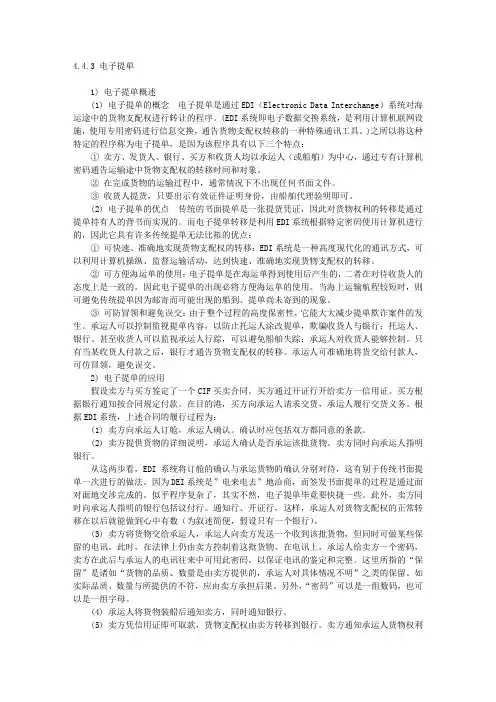
4.4.3 电子提单1) 电子提单概述(1) 电子提单的概念电子提单是通过EDI(Electronic Data Interchange)系统对海运途中的货物支配权进行转让的程序。
(EDI系统即电子数据交换系统,是利用计算机联网设施,使用专用密码进行信息交换,通告货物支配权转移的一种特殊通讯工具。
)之所以将这种特定的程序称为电子提单,是因为该程序具有以下三个特点:①卖方、发货人、银行、买方和收货人均以承运人(或船舶)为中心,通过专有计算机密码通告运输途中货物支配权的转移时间和对象。
②在完成货物的运输过程中,通常情况下不出现任何书面文件。
③收货人提货,只要出示有效证件证明身份,由船舶代理验明即可。
(2) 电子提单的优点传统的书面提单是一张提货凭证,因此对货物权利的转移是通过提单持有人的背书而实现的。
而电子提单转移是利用EDI系统根据特定密码使用计算机进行的,因此它具有许多传统提单无法比拟的优点:①可快速、准确地实现货物支配权的转移:EDI系统是一种高度现代化的通讯方式,可以利用计算机操纵、监督运输活动,达到快速、准确地实现货物支配权的转移。
②可方便海运单的使用:电子提单是在海运单得到使用后产生的,二者在对待收货人的态度上是一致的,因此电子提单的出现必将方便海运单的使用。
当海上运输航程较短时,则可避免传统提单因为邮寄而可能出现的船到、提单尚未寄到的现象。
③可防冒领和避免误交:由于整个过程的高度保密性,它能大大减少提单欺诈案件的发生。
承运人可以控制监视提单内容,以防止托运人涂改提单,欺骗收货人与银行;托运人、银行、甚至收货人可以监视承运人行踪,可以避免船舶失踪;承运人对收货人能够控制。
只有当某收货人付款之后,银行才通告货物支配权的转移。
承运人可准确地将货交给付款人,可仿冒领,避免误交。
2) 电子提单的应用假设卖方与买方签定了一个CIF买卖合同。
买方通过开证行开给卖方一信用证。
买方根据银行通知按合同规定付款。
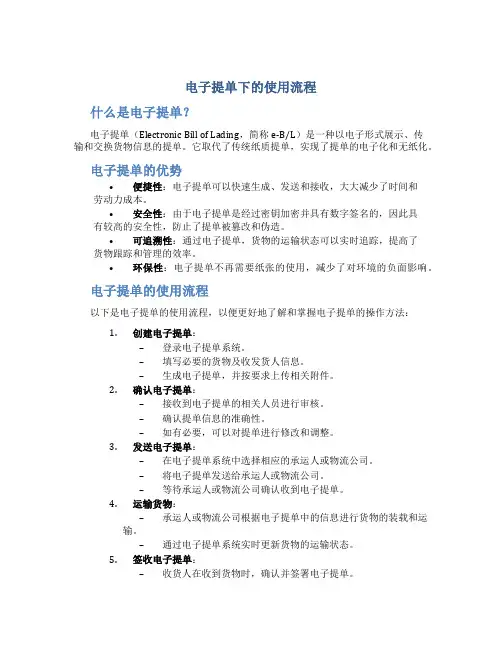
电子提单下的使用流程什么是电子提单?电子提单(Electronic Bill of Lading,简称e-B/L)是一种以电子形式展示、传输和交换货物信息的提单。
它取代了传统纸质提单,实现了提单的电子化和无纸化。
电子提单的优势•便捷性:电子提单可以快速生成、发送和接收,大大减少了时间和劳动力成本。
•安全性:由于电子提单是经过密钥加密并具有数字签名的,因此具有较高的安全性,防止了提单被篡改和伪造。
•可追溯性:通过电子提单,货物的运输状态可以实时追踪,提高了货物跟踪和管理的效率。
•环保性:电子提单不再需要纸张的使用,减少了对环境的负面影响。
电子提单的使用流程以下是电子提单的使用流程,以便更好地了解和掌握电子提单的操作方法:1.创建电子提单:–登录电子提单系统。
–填写必要的货物及收发货人信息。
–生成电子提单,并按要求上传相关附件。
2.确认电子提单:–接收到电子提单的相关人员进行审核。
–确认提单信息的准确性。
–如有必要,可以对提单进行修改和调整。
3.发送电子提单:–在电子提单系统中选择相应的承运人或物流公司。
–将电子提单发送给承运人或物流公司。
–等待承运人或物流公司确认收到电子提单。
4.运输货物:–承运人或物流公司根据电子提单中的信息进行货物的装载和运输。
–通过电子提单系统实时更新货物的运输状态。
5.签收电子提单:–收货人在收到货物时,确认并签署电子提单。
–在电子提单系统中上传签收的电子提单。
–如有异议,及时联系承运人或物流公司解决问题。
6.完结电子提单:–当货物送达目的地并确认无误后,电子提单可以完结。
–在电子提单系统中确认并完结电子提单。
–保存电子提单的相关信息,以备后续参考。
电子提单的注意事项•认真填写信息:在创建电子提单时,务必仔细填写货物及收发货人的信息,保证提单的准确性。
•及时传输电子提单:为了保证货物能够及时出发,需尽快将电子提单发送给承运人或物流公司。
•注意电子提单的状态:在电子提单系统中及时查看和确认电子提单的状态,随时了解货物的运输进展。
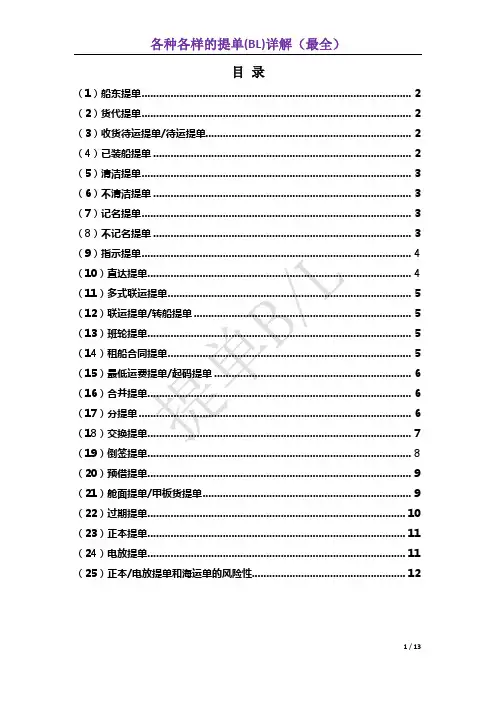
目录(1)船东提单 (2)(2)货代提单 (2)(3)收货待运提单/待运提单 (2)(4)已装船提单 (2)(5)清洁提单 (3)(6)不清洁提单 (3)(7)记名提单 (3)(8)不记名提单 (3)(9)指示提单 (4)(10)直达提单 (4)(11)多式联运提单 (5)(12)联运提单/转船提单 (5)(13)班轮提单 (5)(14)租船合同提单 (5)(15)最低运费提单/起码提单 (6)(16)合并提单 (6)(17)分提单 (6)(18)交换提单 (7)(19)倒签提单 (8)(20)预借提单 (9)(21)舱面提单/甲板货提单 (9)(22)过期提单 (10)(23)正本提单 (11)(24)电放提单 (11)(25)正本/电放提单和海运单的风险性 (12)Master Bill of Lading(简称MBL),指由承运人Carrier(即carrier船公司)向托运人(shipper)签发的提单。
与货代提单House Bill of Lading相对。
船东提单如果要做电放,都要提供电放保函和收取电放费200-500元/MBL。
(2)货代提单House Bill of Lading(简称HBL),由货运代理人(即货代)向托运人签发的提单,通常也叫无船承运人(NVOCC)提单。
做门到门(Door to Door)或运费到付(Ocean Freight Collect)时,一般都要签发货代提单。
是否签发货代提单跟船公司没有关系。
不管是否出货代提单,船公司都会签发船东单。
货代提单做电放,一般不收电放费,尤其是拼箱(LCL)业务。
(3)收货待运提单/待运提单Received for Shipping Bill of Lading,承运人(即Carrier船公司)已经收到货物(Cargo already Received),但是货物还没有装船,这时签发的提单就是收货待运提单。
(4)已装船提单Shipped on Board Bill of Lading,指船公司向托运人签发的货物已经装船的提单。
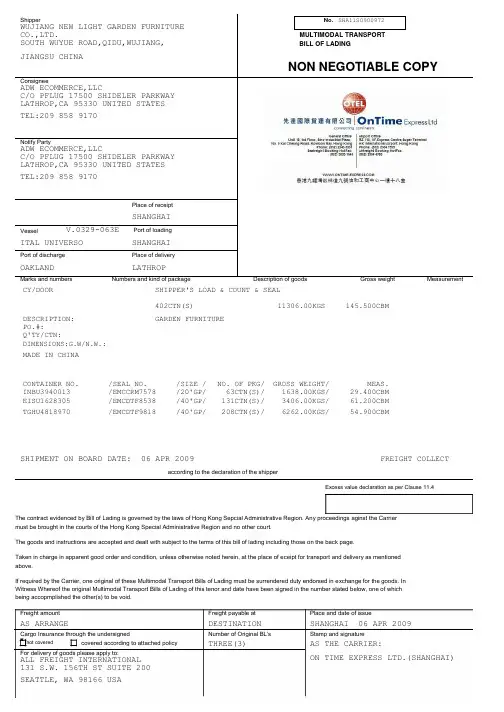
CY/DOOR SHIPPER'S LOAD & COUNT & SEAL402CTN(S)11306.00KGS145.500CBM DESCRIPTION:GARDEN FURNITUREPO.#:Q'TY/CTN:DIMENSIONS:G.W/N.W.:MADE IN CHINACONTAINER NO./SEAL NO./SIZE /NO. OF PKG/GROSS WEIGHT/MEAS.INBU3940013/EMCCRM7578/20'GP/63CTN(S)/1638.00KGS/29.400CBMEISU1628305/EMCDTF8538/40'GP/131CTN(S)/3406.00KGS/61.200CBMTGHU4818970/EMCDTF9818/40'GP/208CTN(S)/6262.00KGS/54.900CBMSHIPMENT ON BOARD DATE: 06 APR 2009FREIGHT COLLECTaccording to the declaration of the shipperExcess value declaration as per Clause 11.4The contract evidenced by Bill of Lading is governed by the laws of Hong Kong Sepcial Administrative Region. Any proceedings aginst the Carriermust be brought in the courts of the Hong Kong Special Administrative Region and no other court.The goods and instructions are accepted and dealt with subject to the terms of this bill of lading including those on the back page.Taken in charge in apparent good order and condition, unless otherwise noted herein, at the place of eceipt for transport and delivery as mentionedabove.If required by the Carrier, one original of these Multimodal Transport Bills of Lading must be surrendered duty endorsed in exchange for the goods. InWitness Whereof the original Multimodal Transport Bills of Lading of this tenor and date have been signed in the number stated below, one of whichbeing accopmplished the other(s) to be void.Freight amount Freight payable at Place and date of issueAS ARRANGE DESTINATION SHANGHAI 06 APR 2009Cargo Insurance through the undersigned Number of Original BL's Stamp and signaturexnot covered covered according to attached policy THREE(3)AS THE CARRIER:For delivery of goods please apply to:ON TIME EXPRESS LTD.(SHANGHAI) ALL FREIGHT INTERNATIONAL131 S.W. 156TH ST SUITE 200SEATTLE, WA 98166 USA。
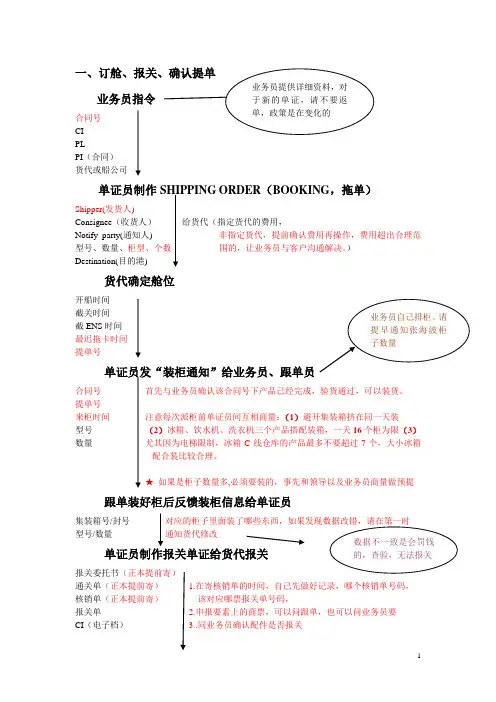
一、订舱、报关、确认提单业务员指令合同号 CI PLPI (合同) 货代或船公司单证员制作SHIPPING ORDER (BOOKING ,拖单)Shipper(发货人)Consignee (收货人) 给货代(指定货代的费用,Notify party(通知人) 非指定货代,提前确认费用再操作,费用超出合理范型号、数量、柜型、个数 围的,让业务员与客户沟通解决。
) Destination(目的港)货代确定舱位开船时间截关时间 截ENS 时间 最迟拖卡时间 提单号单证员发“装柜通知”给业务员、跟单员合同号 首先与业务员确认该合同号下产品已经完成,验货通过,可以装货。
提单号来柜时间 注意每次派柜前单证员间互相商量:(1)避开集装箱挤在同一天装型号 (2)冰箱、饮水机、洗衣机三个产品搭配装箱,一天16个柜为限(3) 数量 尤其因为电梯限制,冰箱C 线仓库的产品最多不要超过7个,大小冰箱配合装比较合理。
★ 如果是柜子数量多,必须要装的,事先和领导以及业务员商量做预提跟单装好柜后反馈装柜信息给单证员集装箱号/封号 对应的柜子里面装了哪些东西,如果发现数据改错,请在第一时 型号/数量 通知货代修改单证员制作报关单证给货代报关 报关委托书(正本提前寄)通关单(正本提前寄) 1.在寄核销单的时间,自己先做好记录,哪个核销单号码, 核销单(正本提前寄) 该对应哪票报关单号码,报关单 2.申报要素上的商票,可以问跟单,也可以问业务员要 CI (电子档) 3..同业务员确认配件是否报关业务员提供详细资料,对于新的单证,请不要返单,政策是在变化的业务员自己排柜。
请提早通知张海波柜子数量数据不一致是会罚钱的,查验,无法报关PL(电子档)PI(合同)(电子档)单证员与货代核对提单BLLC信用证项下,提单上的项目必须按信用上要求来TT,OA,DP项下,必须做到单单一致(第一时间问业务员,是否需要和客户对单)BL正本(留一副本或扫描件存档)开船后,和货代确认费用,拿到正本发票后交资料给财务,(先在张海波那里登记费用,在填写付款联系单,在黄联上盖章,与发票一起交于财务。
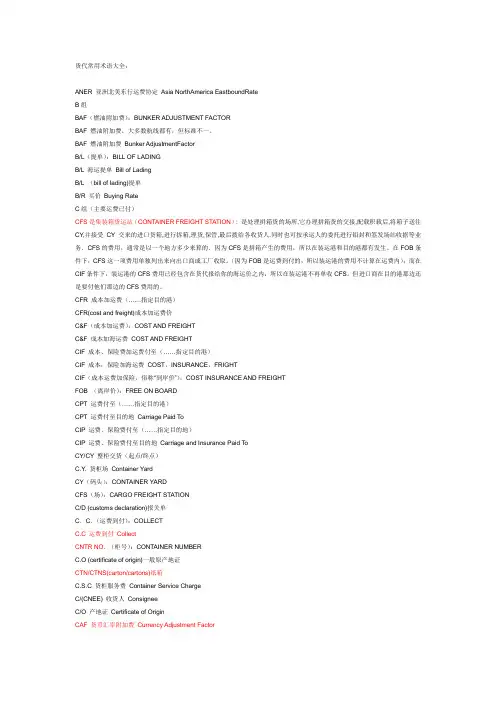
货代常用术语大全:ANER 亚洲北美东行运费协定Asia NorthAmerica EastboundRateB组BAF(燃油附加费):BUNKER ADJUSTMENT FACTORBAF 燃油附加费,大多数航线都有,但标准不一。
BAF 燃油附加费Bunker AdjustmentFactorB/L(提单):BILL OF LADINGB/L 海运提单Bill of LadingB/L (bill of lading)提单B/R 买价Buying RateC组(主要运费已付)CFS是集装箱货运站(CONTAINER FREIGHT STATION): 是处理拼箱货的场所,它办理拼箱货的交接,配载积载后,将箱子送往CY,并接受CY交来的进口货箱,进行拆箱,理货,保管,最后拨给各收货人.同时也可按承运人的委托进行铅封和签发场站收据等业务.CFS的费用,通常是以一个地方多少来算的.因为CFS是拼箱产生的费用,所以在装运港和目的港都有发生。
在FOB条件下,CFS这一项费用单独列出来向出口商或工厂收取。
(因为FOB是运费到付的,所以装运港的费用不计算在运费内);而在CIF条件下,装运港的CFS费用已经包含在货代报给你的海运价之内,所以在装运港不再单收CFS。
但进口商在目的港那边还是要付他们那边的CFS费用的。
CFR 成本加运费(……指定目的港)CFR(cost and freight)成本加运费价C&F(成本加运费):COST AND FREIGHTC&F 成本加海运费COST AND FREIGHTCIF 成本、保险费加运费付至(……指定目的港)CIF 成本,保险加海运费COST,INSURANCE,FRIGHTCIF(成本运费加保险,俗称“到岸价”):COST INSURANCE AND FREIGHTFOB (离岸价):FREE ON BOARDCPT 运费付至(……指定目的港)CPT 运费付至目的地Carriage Paid ToCIP 运费、保险费付至(……指定目的地)CIP 运费、保险费付至目的地Carriage and Insurance Paid ToCY/CY 整柜交货(起点/终点)C.Y. 货柜场Container YardCY(码头):CONTAINER YARDCFS(场):CARGO FREIGHT STATIONC/D (customs declaration)报关单C.C.(运费到付):COLLECTC.C 运费到付CollectCNTR NO. (柜号):CONTAINER NUMBERC.O (certificate of origin)一般原产地证CTN/CTNS(carton/cartons)纸箱C.S.C 货柜服务费Container Service ChargeC/(CNEE) 收货人ConsigneeC/O 产地证Certificate of OriginCAF 货币汇率附加费Currency Adjustment FactorCFS 散货仓库Container Freight Station CFS/CFS 散装交货(起点/终点)CHB 报关行Customs House BrokerCOMM 商品CommodityCTNR 柜子ContainerD组(到达)DAF 边境交货(……指定地点)DAF 边境交货Delivered At FrontierDES 目的港船上交货(……指定目的港)DES 目的港船上交货Delivered Ex ShipDEQ 目的港码头交货(……指定目的港)DEQ 目的港码头交货Delivered Ex QuayDDU 未完税交货(……指定目的地)DDU 未完税交货Delivered Duty UnpaidDDP 完税后交货(……指定目的地)DDP 完税后交货Delivered Duty PaidDDC、IAC 直航附加费,美加航线使用DDC 目的港码头费Destination Delivery ChargeDL/DLS(dollar/dollars)美元D/P(document against payment)付款交单D/P 付款交单Document Against PaymentDOC (document)文件、单据DOC(文件费):DOCUMENT CHARGEDoc# 文件号码Document NumberD/A (document against acceptance)承兑交单D/A 承兑交单Document Against AcceptanceDOZ/DZ(dozen)一打D/O 到港通知Delivery OrderE组(发货)EXW 工厂交货(……指定地点)Ex 工厂交货Work/ExFactoryETA(到港日):ESTIMATED TIME OF ARRIVALETD(开船日):ESTIMATED TIME OF DELIVERYETC(截关日):ESTIMATED TIME OF CLOSINGEBS、EBA 部分航线燃油附加费的表示方式,EBS一般是澳洲航线使用,EBA一般是非洲航线、中南美航线使用EXP(export)出口EA(each)每个,各EPS 设备位置附加费Equipment Position SurchargesF组(主要运费未付)FCA 货交承运人(……指定地点)FCA 货交承运人Free CarrierFCR: FORWARDING CARGO RECEIPTFAS 船边交货(……指定装运港)FOB 船上交货(……指定装运港)FOB 船上交货Free On BoardFOB (离岸价):FREE ON BOARDCIF(成本运费加保险,俗称“到岸价”):COST INSURANCE AND FREIGHT FCL(整箱货):FULL CONTAINER CARGO LOADFCL 整柜Full Container LoadLCL(拼箱货):LESS THAN ONECONTAINER CARGO LOADFAF 燃油价调整附加费(日本航线专用)FAF 燃料附加费Fuel Adjustment FactorFAC(facsimile)传真Form A ---产地证(贸易公司)F/F 货运代理Freight ForwarderFAK 各种货品Freight All KindFAS 装运港船边交货Free Alongside ShipFeeder Vessel/Lighter 驳船航次FEU 40‘柜型Forty-Foot Equivalent Unit 40’FMC 联邦海事委员会Federal Maritime CommissionFIO是FREE IN AND OUT的意思,指船公司不付装船和卸船费用FIOST条款,指船公司不负责装,卸,平舱,理舱FI是FREE IN的意思,指船公司不付装FO是FREE OUT的意思,同理指船公司不付卸G组GRI 综合费率上涨附加费,一般是南美航线、美国航线使用GRI 全面涨价General Rate IncreaseG.W.(gross weight)毛重G.W.(gross weight)毛重N.W.(net weight)净重G.S.P.(generalized system of preferences)普惠制H组HB/L(货代提单):HOUSE BILL OF LADINGHBL 子提单House B/LH/C 代理费Handling ChargeI 组IFA 临时燃油附加费,某些航线临时使用INT(international)国际的INV (invoice)发票IMP(import)进口I/S 内销售Inside SalesIA 各别调价Independent ActionJ 组JP---代表“日元”L组FCL(整箱货):FULL CONTAINER CARGO LOADLCL(拼箱货):LESS THAN ONECONTAINER CARGO LOADLCL 拼柜Less Than Container LoadL/C (letter of credit)信用证L/C 信用证Letter of CreditLand Bridge 陆桥M 组MB/L 主提单Master Bill Of LoadingMIN (minimum)最小的,最低限度M/V(merchant vessel)商船MT或M/T(metric ton)公吨M/T 尺码吨(即货物收费以尺码计费)Measurement TonMAX (maximum)最大的、最大限度的M 或MED (medium)中等,中级的MLB 小陆桥,自一港到另一港口Minni Land BridgeMother Vessel 主线船MTD 多式联运单据Multimodal Transport DocumentN组NOVCC(无船承运人):NON VESSEL OPRERATING COMMON CARRIERNVOCC 无船承运人Non Vessel Operating Common CarrierN.W.(net weight)净重N/F 通知人NotifyO组O/F 海运费Ocean FreightO/F(海运费):OCEAN FREIGHTORC(广东地区原产地收货费):ORIGINAL RECEIVING CHARGEOB/L(海运提单):OCEAN BILL OF LADINGOBL 海运提单Ocean (or original )B/LORC 本地出口附加费,和SPS类似,一般在华南地区使用(广东省收取)(Original Received Charge,中文为:港口建设费,远航时收:如货物从深圳发往美洲、欧盟等国家时收)OCP 货主自行安排运到内陆点Overland Continental PointOP 操作OperationP组POD 目地港Port Of DestinationPOL 装运港Port Of LoadingPSS 旺季附加费Peak Season SuchargesPSS(旺季附加费):PEAK CEASON SURCHARGEPSS 旺季附加费,大多数航线在运输旺季时可能临时使用REF (reference)参考、查价RMB(renminbi)人民币PR或PRC(price) 价格P/P(运费预付):FREIGHT PREPAIDP.P 预付PrepaidPCS 港口拥挤附加费,一般是以色列、印度某些港口及中南美航线使用PCS 港口拥挤附加费Port Congestion SurchargePTF 巴拿马运河附加费,美国航线、中南美航线使用PKG(package)一包,一捆,一扎,一件等PCE/PCS(piece/pieces)只、个、支等P/L (packing list)装箱单、明细表PCT (percent)百分比PUR (purchase)购买、购货S组S/O(订舱单):SHIPPING ORDERS/O 装货指示书Shipping OrderSEAL NO. (铅封号)S/C(sales contract)销售确认书S/C 售货合同Sales ContractSC 服务合同Service ContractSTL.(style)式样、款式、类型SPS 上海港口附加费(船挂上港九区、十区)S.S(steamship)船运S/M (shipping marks)装船标记S/(Shpr) 发货人ShipperS/R 卖价Selling RateS/S Spread Sheet Spread SheetSSL 船公司Steam Ship LineSDR special drawing rights 特别提款权T组TELEX FEE电放费,电放就是指不需要出提单正本,直接传电子档给客户,省去了出提单正本和快递的过程THC(码头费):英文全称为"Terminal handling charge",译为"港口操作费用",是2002年1月15日由国际航运协会统一制定的用于补偿承运人且独立于运保费之外,强制性地向收发货人征收的一种运输附加费。
海运提单BL空白版国际海运提单BILL OF LADING 空白版Date:SHIP FROMBILL OF LADINGPage 1 of ______Name: Address: City/State/Zip: SID#:SHIP TOBill of Lading Number: ________________________BAR CODE __B:__ NAME: _________________________________Name: Address: City/State/Zip: CID#:Location#: __________Trailer number: Seal number(s): SCAC: Pro number:FOB:THIRD PARTY __ __ BILL TO:Name: Address: City/State/Zip: __ __TIONS:BAR CODE SPACEFreight Charge Terms: (freight charges are prepaid unlessmarked otherwise)Prepaid ________(check box)Collect _______3rd Party ______Master Bill of Lading: with attached underlying Bills of Lading __NAL __ INFO__R ORDER NUMBER# PKGS__R ORDER __TION PALLET/SLIP WEIGHT(CIRCLE ONE)Y Y Y Y Y Y Y YN N N N N N N NGRAND __RRIER __TION __G UNITQTYTYPE__ QTY TYPE__TY __TION __.M. (X)Commodities requiring special or additional care or attention in handling or stowing must be so marked and packaged as to ensure safe transportation with ordinary care. See Section 2(e) of NMFC Item 360LTL __C# CLASS__NG STAM P SPACEWhere the rate is dependent on value, shippers are required to state specifically in writing the agreed or declared value of the property as follows:“The agreed or declared value of the property is specifically stated by the shipper to be not exceeding __________________ per ___________________.” __D, subject to individually determined rates or contracts that have been agreedupon in writing between the carrier and shipper, if applicable, otherwise to the rates, classifications and rules that have been established by the carrier and are available to the shipper, on request, and to all applicable state and federal regulations.GRAND TOTAL COD Amount:$ ______________________Fee Terms: Collect: Prepaid: Customer check acceptable: __(c)(1)(A) and (B).The carrier shall not make delivery of this shipment without payment of freight and all other lawful charges.NOTE Liability Limitation for loss or damage in this shipment may be applicable. See 49 U.S.C._______________________________________Shipper Signature__ __RE/ DATEThis is to certify that the above named materials are properly classified, packaged, marked and labeled, and are in proper condition for transportation according to the applicable regulations of the DOT.Trailer Loaded:By Shipper By DriverFreight Counted:By Shipper By Driver/pallets said to contain By Driver/Pieces__ __RE/ PICKUP DATECarrier acknowledges receipt of packages and required placards. Carrier certifies emergency response information was made available and/or carrier has theDOT emergency response guidebook or equivalent documentation in the vehicle. Property described above is received in good order, except as noted.。
CODE NAME: “CONGENBILL” . EDITION 1994Page 2ShipperPETROL METAL ENGINEER CO.,LIMITED BILL OF LADING B/L No.SHP01 TO BE USED WITH CHARTER-PARTIESReference No.ConsigneeTO ORDERNotify address TO ORDERVesselMV JINDA Port of loading PERSIAN GULFPort of dischargeMAIN PORT,CHINAShipper’s description of goods Gross weight MeasurementIRON ORE LUMP 33,869.802 MTSPACKING IN BULKCLEAN ON BOARDFREIGHT PAYBABLE AS PER CHARTER PARTY(of which on deck at Shipper’s risk; the Carrier notbeing responsible for loss or damage howsoever arising)Freight payable as perCHARTER-PARTY dated………………………………………………FREIGHT ADVANCE.Received on account of freight: ……………………………………………………………………………Time used for loading………………..days…………………….hoursSHIPPED at the Port of loading in apparent good order and conditionOn board the Vessel for carriage to the Port of Dischargeor so near there to as she may safely get the goods specified above.Weight, measure, quality, condition, contents and value unknown.IN WITNESS whereof the Master or Agent of the said Vessel has signed the number of Bills of Lading indicated below all of this tenor and date any one of which being accomplished the others shall be void.FOR CONDITIONS OF CARRIAGE SEE OVERLEAFFreight payable at Place and date of issueBEIJING AUG 25 2013Printed and sold byFr.G. Knudtzons Bogtrykkeri A/S, 55 Toldbodgade, DK-1253 Copenhagen K,Telexfax +45 33 93 11 84by authority of the Baltic and international Maritime Council (BIMCO), Copenhagen.Number of original Bs/LTHREE (3)SignatureFOR AND ON BEHALF OF MASTER MV.JINDA CAPT. SUN QINGSONGBILL OF LADING Page 1TO BE USED WITH CHARTER-PARTIESCODE NAME: “CONGENBILL”EDITION 1994ADOPTED BYTHE BALTIC AND INTERNATIONAL MARITIME COUNCIL (BIMCO)Conditions of Carriage.(1) All terms and conditions, liberties and exceptions of the Charter Party, dated as overleaf, including the Law and Arbitration Clause, are herewith incorporated.(2) General Paramount Clause.(a) The Hague Rules contained in the International Convention for the Unification of certain rules relating to Bills of Lading, dated Brussels the 25th August1924 as enacted in the country of shipment shall apply to this Bill of Lading. When no such enactment is in force in the country of shipment, the corresponding legislation of the country of destination shall apply, but in respect of shipments to which no such enactments are compulsorily applicable, the terms of the said Convention shall apply.(b) Trades where Hague-Visby Rules apply.In trades where the International Brussels Convention 1924 as amended by the Protocol signed at Brussels on February 23rd 1968 - the Hague-Visby Rules - apply compulsorily, the provisions of the respective legislation shall apply to this Bill of Lading.(c) The Carrier shall in no case be responsible for loss of or damage to the cargo, howsoever arising prior to loading into and after discharge from the Vessel orwhile the cargo is in the charge of another Carrier, nor in respect of deck cargo and live animals.(3) General average.General Average shall be adjusted, stated and settled according to York-Antwerp Rules 1994, or any subsequent modification thereof, in London unless another place is agreed in the Charter Party.Cargo’s contribution to General Average shall be paid to Carrier even when such average is the result of a fault, neglect or error of the Master, Pilot or Crew. The Charterers, shippers and Consignees expressly renounce the Belgian Commercial Code, Part II, Art. 148.(4) New Jason Clause.In the event of accident, danger, damage or disaster before or after the commencement of the voyage, resulting from any cause whatsoever, whether due to negligence or not, for which, or for the consequence of which, the Carrier is not responsible, by statute, contract or otherwise, the cargo, shippers, consignees or the owners of the cargo shall contribute with the Carrier in general average to the payment of any sacrifices, losses or expenses of a General Average nature that may be made or incurred and shall pay salvage and special charges incurred in respect of the cargo. If a salving vessel is owned or operated by the Carrier, salvage shall be paid for as fully as if the said salving vessel or vessels belonged to strangers. Such deposit as the Carrier, or his agents, may deem sufficient to cover the estimated contribution of the goods and any salvage and special charges thereon shall, if required, be made by the cargo, shippers, consignees or owners of the goods to the Carrier before delivery.(5) Both-to-Blame Collision Clause.If the Vessel comes into collision with another vessel as a result of the negligence of the other vessel and any act, neglect or default of the Master, Mariner, Pilot or the servants of the Carrier in the navigation or in the management of the Vessel, the owners of the cargo carried hereunder will indemnify the Carrier against all loss or liability to the other or non-carrying vessel or her owners in so far as such loss or liability represents loss of, or damage to, or any claim whatsoever of the owners of said cargo, paid or payable by the other or non-carrying vessel or her owners to the owners of said cargo and set-off, recouped or recovered by the other or non-carrying vessel or her owners as part of their claim against the carrying Vessel or the Carrier.The foregoing provisions shall also apply where the owners, operators or those in charge of any vessel or vessels or objects other than, or in addition to, the colliding vessels or objects are at fault in respect of a collision or contact.For particulars of cargo, freight,Destination, etc., see overleaf.。